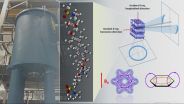(Press-News.org) Food waste has become a serious problem in the United States and other countries. Approximately 34 million tons of food waste is deposited in landfills each year in the United States alone (EPA, 2014). The U.S. Environmental Protection Agency has recognized the use of food waste as animal feed as one of the best means to add value to food waste, while reducing landfill costs and greenhouse gas emissions, and at the same time improving food security.
In an article published in the November 2014 issue of the Journal of Animal Science ("Nutritional value of ensiled grocery food waste for cattle") a team of researchers from the University of Georgia, Athens, sought to better understand the nutritional value and cost-effectiveness of using grocery food waste (vegetables, fruit, and bakery goods) recycled from large retail stores as a feed source for livestock. Grocery food waste represents as much as 10% of food waste, and the authors argued that, "Ruminants are especially advantaged to digest and use food waste of plant origin."
Initially, the research team analyzed 115 samples of grocery byproduct (GBP) from a food waste recycling company (Viridiun, LLC, Cumming, GA) for variation in nutrients and feed value. The samples of grocery food waste were from the southern United States (Alabama, Florida, Georgia, South Carolina, and Texas) and contained vegetable, fruit, and fresh bakery items. Even though the predicted energy content was relatively high and consistent on a dry-matter basis, the authors concluded, "As a feed, GBP is highly variable in moisture and nutrient content and does not conform well to having set nutritional standards for feeding or determining value," and therefore, "each load of GBP should be assessed individually to ascertain specifications needed for its proper feeding and valorization."
Based on this conclusion, the team hypothesized that the product could be partially dried and preserved by ensiling, as with vegetative forages, to cope with its highly variable moisture (approximately 80%) and nutrient contents. After processing GBP into slurry and putting it through various drying treatments, the material was found to effectively ensile without drying, as determined by changes in pH, soluble carbohydrates, and fermentation acids. The authors concluded, "... an appreciable amount of moisture can be removed from processed GBP passively by allowing it to seep [for 24 hours]" and "... GBP treatments that were more dry at ensiling were higher in pH and lower in fermentation acids after ensiling, indicating that drying restricted fermentation."
Once the nutritive value and stability of GBP was established, the research team conducted a cattle feeding and digestibility study to determine intake, digestibility, and energy content of the GBP. Yearling Holstein steers were fed 4 inclusion levels of ensiled GBP (substituting GBP for the basal ration at 0, 20, 40, and 60% on a DM basis for 90.8% of the total ration DM) in a total mixed ration, and energy content was determined. Results showed that increasing GBP increased dry matter intake and apparent digestibility, and over the entire 8-wk period the steers gained an average of 1.27 kg/d, regardless of dietary treatment. These data confirm the effectiveness of using ensiled GBP as a supplemental energy feed in total mixed rations for cattle.
The researchers also developed a method for pricing GBP that accounts for variation in nutrient content and feed markets. Dr. Mark Froetschel, Professor of Animal & Dairy Science at the University of Georgia (retired) and co-author of the study, stated, "... an equation was developed to price grocery byproduct on its moisture, energy, and protein concentrations and current prices of corn and soybean meal."
Dr. Froetschel continued, "This research documents the nutritional value of a cost-effective alternative [feed] for cattle. Evidence collected in commercial practice suggests that this feed is conducive to animal health and performance, product quality, and food safety. Grocery byproduct has extrinsic and intrinsic value for cattle producers and consumers in the more populated regions of the U.S." Now, the next step will be to confirm these observations in large, controlled feeding experiments with cattle.
INFORMATION:
Wheat, along with corn and barley, is one of the three major feed grains used in North America. Most of the feed-class wheat is fed to poultry and swine. Beef producers are reluctant to use large quantities of wheat in diets of feedlot cattle because wheat ferments considerably more rapidly in the rumen than corn or barley and increases the risk of ruminal acidosis, which can compromise the health, wellbeing, and productivity of cattle.
In a study published in the November 2014 issue of the Journal of Animal Science ("Impact of hard vs. soft wheat and monensin level on ...
When the dinosaurs ruled the earth, they were already bugged by creatures who had gotten there many millions of years earlier: Dragonflies and damselflies. In fact, says Rutgers University-Newark biologist, Dr. Jessica Ware, the first creatures to take to the skies of earth did so 406 million years ago.
Ware knows of what she speaks: She is part of an international team of 100 researchers that just finished an unprecedented two-year project to map the evolution of insects using a molecular data set of unparalleled quality and dimensions. The initial report on their ...
Most cancer deaths occur because of metastasis, yet progress in preventing and treating migratory cancer cells has been slow.
"It's been particularly challenging to design drugs that work against metastasis," said Taran Gujral, research fellow in systems biology at Harvard Medical School.
"Unfortunately, many cancers aren't detected until after they've already metastasized."
Gujral and colleagues have now identified a cellular culprit that should help researchers better understand how metastasis begins. Their findings may also inform the design of new treatments ...
Pain is a common symptom of cancer and side effect of cancer treatment, and treating cancer-related pain is often a challenge for health care providers.
The Penny George Institute for Health and Healing researchers found that integrative medicine therapies can substantially decrease pain and anxiety for hospitalized cancer patients. Their findings are published in the current issue of the Journal of the National Cancer Institute Monographs.
"Following Integrative medicine interventions, such as medical massage, acupuncture, guided imagery or relaxation response ...
MADISON, Wis. -- Here is an idea worth following: "share" for tenure; "like" to get cited.
Academic researchers are turning to social media more and more, according to Dominique Brossard, and not just to post family photos or crack wise via hashtag.
"I've been in science communication for a while now, and I am really seeing a change -- especially among the younger scientists -- in their willingness to share their work," says Brossard, a University of Wisconsin-Madison professor of life sciences communication.
It's the venue for that sharing that has inspired work ...
OAK RIDGE, Tenn., Nov. 6, 2014 - For much the same reason LCD televisions offer eye-popping performance, a thermomagnetic processing method developed at the Department of Energy's Oak Ridge National Laboratory can advance the performance of polymers.
Polymers are used in cars, planes and hundreds of consumer products, and scientists have long been challenged to create polymers that are immune to shape-altering thermal expansion. One way to achieve this goal is to develop highly directional crystalline structures that mimic those of transparent liquid crystal diode, or ...
PITTSBURGH--Speed is an asset for a predator. Except when that predator runs so fast that it essentially blinds itself.
The tiger beetle, relative to its size, is the fastest creature on Earth. Some of these half-inch-long beetles cover about 120 body lengths per second (at about five miles per hour). The fastest human can do about five body lengths. To take the sprinting gold from the tiger beetle, a person would have to hit 480 miles per hour.
BUT! The tiger beetle has a problem. At peak speeds, everything becomes a blur. They can't gather enough light with their ...
LAWRENCE -- The number of children diagnosed with autism has increased in recent years, but a new study co-authored by a University of Kansas professor shows that while the number of students with autism increased in every state from 2000 to 2007, black and Hispanic children were significantly underrepresented.
Jason Travers, assistant professor of special education, co-authored a study that analyzed administrative identification of autism in every state under the Individuals with Disabilities Education Act for the years 2000 and 2007. The disparity in the odds of white ...
The distribution of birds in the United States today will probably look very different in 60 years as a result of climate, land use and land cover changes.
A new U.S. Geological Survey study predicts where 50 bird species will breed, feed and live in the conterminous U.S. by 2075. While some types of birds, like the Baird's sparrow, will likely lose a significant amount of their current U.S. range, other ranges could nearly double. Human activity will drive many of these shifts. The study was published today in the journal PLOS ONE.
"Habitat loss is a strong predictor ...
NASA's Terra satellite passed over Tropical Storm Nuri on Nov. at captured an infrared picture of the storm. The storm looked more like a frontal system as it stretched from northeast to southwest.
The Moderate Resolution Imaging Spectroradiometer or MODIS instrument that flies aboard NASA's Terra satellite flew over Nuri on Nov. 6 at 1240 UTC (7:40 a.m. EST). The MODIS image showed some strong thunderstorms remaining in a small area around Nuri's center, but the storm appeared stretched out from northeast to southwest. Wind shear was affecting the storm, stretching it ...

